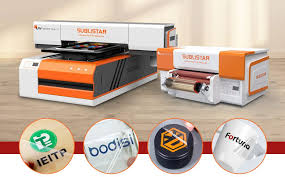UV printing technology, a crucial component of contemporary printing technology, has exhibited rapid development and extensive global adoption in recent years. In advertising production, decoration industry, industrial manufacturing, electronic product identification, personalized gifts, architectural decoration, and other fields, UV printers with their high precision, high speed, high efficiency, and environmental protection have shown a strong market potential and broad prospects for development. This paper will systematically examine the present state and future potential of the UV printing business from many viewpoints.
Overview of UV printing technique
UV printing technology is a type of inkjet printing technology that utilizes ink coated with ultraviolet curing agents. UV printing provides several advantages over conventional printing technology, including rapid curing speed, significant color reduction, robust wear resistance, environmental protection, and energy efficiency. UV ink undergoes rapid curing when exposed to ultraviolet radiation, eliminating the need for heating and drying. This process significantly enhances manufacturing efficiency, decreases energy usage and emissions of volatile organic compounds (VOCs), and effectively complies with contemporary environmental regulations.

1. Analysis of the industry performance
(1) Market size and production figures
The newest research indicates that the worldwide UV digital inkjet printer market size achieved a value of $1,436.63 million in 2023, exhibiting a compound yearly growth rate (CAGR) of 3.75%. At a compound annual growth rate (CAGR) of 4.42%, this market is projected to reach $2,012.92 million by 2030. Within the Chinese market, the production of UV printers has reached a staggering 49.875 million units, establishing itself as a significant global market for both manufacturers and consumers. The estimated value of China’s UV printer market in 2023 is 189.37 million US dollars, with a projected growth to 244.37 million US dollars by 2030.
(2) Analysis of industrial chains
The UV printer industry chain comprises suppliers of raw materials and components, intermediate printer production companies, and final sales outlets. The primary suppliers in the upstream sector are electronic components and engineering plastics, while the midstream link involves the production and assembly of printers. The downstream sales channels include offline dealers, agents, stores, as well as online e-commerce platforms and social media. The primary locations for UV printer manufacturing in China include Guangdong, Chongqing, Shandong, Shanghai, and other regions. Among them, Guangdong accounted for 50.90% of the total production activity.
(3) Competition trend among brands
Currently, the prominent brands in the worldwide UV printer industry are EPSON, Canon, Durst, Fujifilm, and EFI, among others. By virtue of their sophisticated technology, extensive product ranges, and robust brand influence, these companies dominate a significant portion of the market. Of course, under the influence of these well-known brands, certain corporate brands also have a considerable market influence. For instance, research reports on the global digital inkjet printing in the textile industry indicate that Sublistar, a company based in China, has significant potential. It is anticipated that Sublistar would enhance its market share by means of technology advancements and strategic exploration of novel product shapes.
2. Analysis of industry prospects
(1) Advancements in technology and innovation
Ongoing advancements and novel developments in UV printing technology are crucial catalysts for the industry’s growth. Through ongoing advancements in inkjet printing technology, the curing speed of UV ink has increased, leading to more precise color restoration and thus enhancing printing efficiency and quality. Furthermore, UV printers possess the capability to achieve superior printing on a wide range of materials such as glass, metal, plastic, ceramics, etc., so expanding its range of applications.
(2) Market demand diversification
Ultraviolet (UV) printing technology has demonstrated significant benefits in meeting the growing need for personalised and customised items among consumers and businesses. UV printers offer efficient, accurate, and versatile solutions for a wide range of applications, including the production of personalized gifts, decorations, industrial items, and advertising signs. UV printers find application in the advertising sector by generating large-format advertising posters, light box films, and promotional panels, therefore augmenting the visual impact and appeal of advertising materials. Within the realm of home decoration, UV printers have the capability to produce customized wallpaper, ornamental paintings, and other objects, thereby fulfilling individuals’ want for a distinctive home ambiance. UV printers are crucial in industrial production for tasks such as part identification and coding, which enhance the efficiency and precision of production processing.
(3) Advantages of environmental preservation
When compared to conventional solvent inkjet and thermal transfer technologies, UV printing technology offers substantial environmental benefits. In accordance with contemporary environmental regulations and energy conservation criteria, the UV printing method is devoid of volatile organic compounds (VOCs) and exhibits minimal energy usage. This characteristic has increasingly resonated with a growing number of consumers and businesses, therefore facilitating the widespread adoption and utilization of UV printing technology.

3. Advancement of cutting-edge application domains
UV printing technology is persistently expanding into several fields of application, including medical devices, electronic equipment identification, automotive components, construction materials, and more. The demands of these emerging fields for exceptional accuracy, resilience, and environmental compatibility align with the benefits of UV printing technology, thereby creating a substantial market opportunity. The ongoing advancement of technology and the ongoing invention of materials will lead to the expansion of the application domain of UV printers, so providing further industries with efficient and precise printing solutions.
4. Support from policies and market conditions
In order to offer financial, fiscal, technical, and talent assistance to the digital printing equipment manufacturing sector, the state and government have implemented a range of laws and regulations. The aforementioned rules have effectively established a favorable commercial climate for makers of UV digital inkjet printers and significantly facilitated the growth of the sector. Simultaneously, the escalation of market competition has also compelled firms to consistently augment their investment in research and development, enhance the quality of their products, and strengthen their ability to innovate, all aim at better satisfying market demand.
5. Obstacles
However, despite the optimistic outlook of the UV printing sector, there remain certain obstacles. Firstly, it is worth noting that international manufacturers possess advanced technology, while local firms continue to face technical limitations in the areas of inkjet control systems and sprinkler engineering, leading to increased expenses. Furthermore, the market competition is intense, prompting firms to use a low-price competition strategy in order to claim a larger market share and upset the market environment. Furthermore, given the ongoing advancement of technology and the perennial fluctuations in the market, organizations must persist in allocating resources towards research and development in order to sustain their technological supremacy and market competitiveness.
The potential of UV printers is not solely decided by their capabilities, but rather by their status as digital printing equipment. These printers offer advantages in replacing certain conventional processes and in the printing domain, without any more significant drawbacks.
The potential of this is contingent upon the user’s ability to effectively engage with the market and the target audience. However, it also requires a significant level of business acumen, marketing skills, channel proficiency, and other related factors in order to generate profits.
Expressing unwarranted confidence in the potential of UV printers is reckless, and it is essential to identify the appropriate entry point, select equipment with market competitiveness, and refrain from making uninformed investments.
Conclusion Therefore, the UV printing industry, with its exceptional precision, rapidity, efficiency, and environmental friendliness, has a significant market potential and wide prospects for growth in several sectors. Under the ongoing advancement of technology and the changing demands of the industry, UV printing technology will maintain its significant role in several sectors like advertising, packaging, decoration, and industrial manufacture. Simultaneously, the alignment of government regulations and the escalation of market rivalry would also facilitate the ongoing growth of the UV printing sector. Nevertheless, when confronted with obstacles such as technical limitations, market rivalry, and ongoing investment, organizations must consistently innovate and enhance their existing capabilities to adapt to forthcoming market fluctuations.




